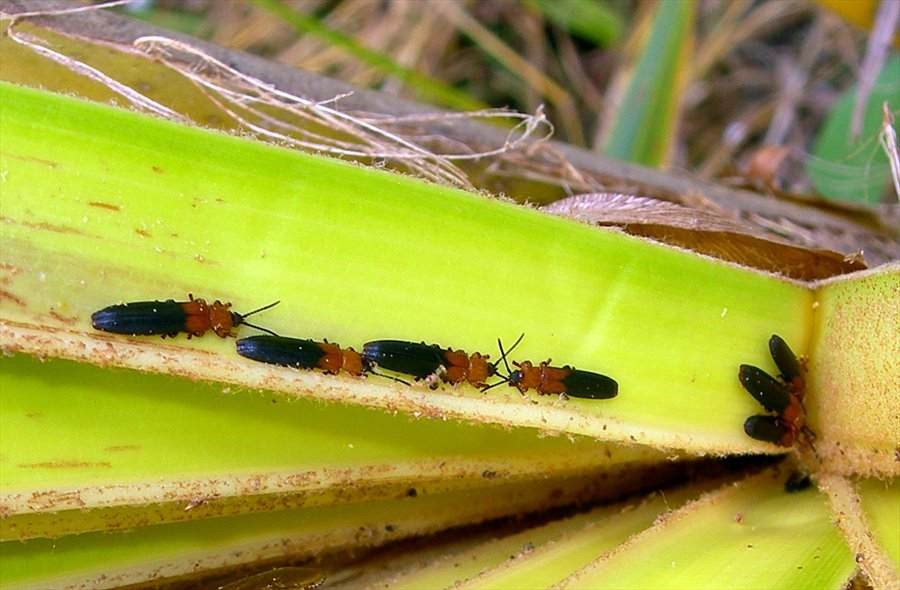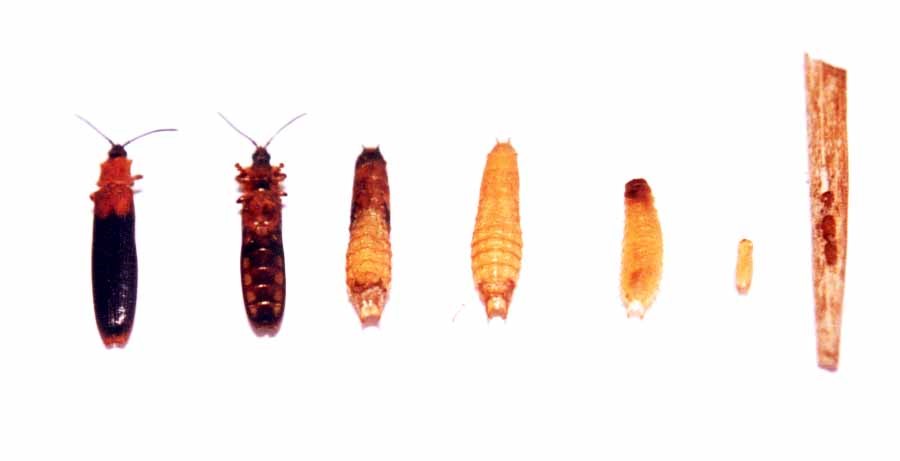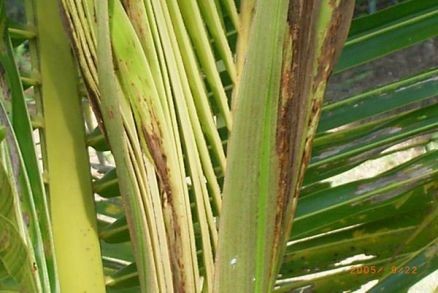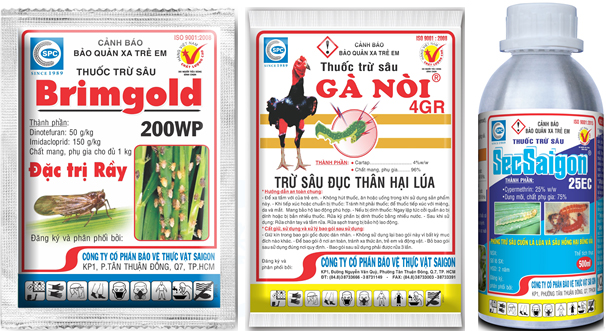|
Coconut beetle: Damages and prevention
17/12/2021
MSc: Huynh Kim Ngoc Damages: The coconut beetle, also known as the coconut beetle, originated in Indonesia, then spread to islands in the Pacific Ocean such as the Salomon Islands (1929), Vanuatu (1937), Tahiti (1961), Australia (1984)... In Southeast Asia, the coconut beetle was discovered and damaged between 1999 and 2000. In Cambodia (2001) nearly 2 million coconut trees died and 7.2 million trees were damaged by the beetle. In Indonesia, the coconut beetle is the main pest in most of the coconut growing provinces here. In Malaysia, the coconut beetle (Pleisispa reichei) is considered the most dangerous pest for the coconut and ornamental coconut industry across the country. In Myanmar, the coconut beetle was discovered to cause harm later (2004), but the authorities raised the alarm and urgently sought countermeasures. In Thailand, coconut beetles cause serious damage and threaten the coconut industry in the southern and central provinces of the country, where the annual value of coconut farming is up to 30 million dollars and affecting directly affects 50,000 smallholder farmers, in addition, seriously threatens the tourism industry. In Vietnam, the coconut beetle was first recorded in the Mekong River Delta in 1999 and the damage caused by the beetle was estimated at 17.8 million dollars (2002), the cost of using pesticides was up to 722,000 dollars... However, the coconut beetle epidemic continues to spread rapidly through other provinces in the South Central Coast, in addition to affecting the income of farmers, coconut beetles also affect the famous tourist landscape in the country. and the ecological environment due to improper use of insecticides against coconut beetles… Classification: The coconut leaf beetle (coconut hispine beetle, coconut leaf beetle, The two-colored coconut leaf beetle) has the scientific name Brontispa longissima (Gestro), belongs to the Iridescent family (Chrysomelidae), the beetle (Coleoptera), the class Insecta (Insecta). the arthropod (Arthropoda), the animal kingdom (Animalia). Host: Up to now, coconut beetles have been recorded to harm many plants of the areca family, coconut (Palmae), in which mainly coconut in the nursery stage, especially young trees in the garden. Biological and harmful properties: Eggs: oval, slightly flattened, dark brown, laid out discretely attached to the leaves of unopened bud, the eggs stick to the leaf surface in long rows. Eggs hatch 4-5 days after laying. 1 female is capable of laying 120 eggs. Larva: Have 5 levels of age (There are documents that say 4 levels of age), 1st year old larva is white, the head is a bit big compared to the body, on the surface of the chitin layer there are small spines, the 2nd age larva has long spines on either side of the body and a pair of pincer-like spines at the end of the abdomen, the adult larva has a slightly flattened body that turns yellow-brown, consisting of 13 segments. Newly-hatched larvae begin to feed on young leaves, are less mobile and tend to be photophobia. Larvae are more harmful than adults. The larval stage lasts about 30-40 days. Pupae: Similar to 5-year-old larvae, but the body is slightly retracted. The pupal stage lasts about 6 days in the space between of young leaves.
Insects: Head is dark brown, with long antennae, thorax is yellow-brown, fore wings are black, wing tips are yellow-brown, wings are iridescent, on the wings there are white dots running along the wings. Males are smaller than females. Adults also do not like light, are not attracted to light, are mainly active and move (fly) at night. Insects cause damage in young leaves by scraping the epidermis of young leaves and excreting manure in place, so the residence and damage of the coconut beetle is very dirty, so the symptoms of damage caused by the coconut beetle are on the unfolded young leaves. We see dark brown stripes running along the leaf veins, When the damaged young leaves unfurl, we see dry, wilted leaves, fringed edges and drooping leaves.When the leaves die, the larvae will move down the petiole (sheath) below to wait for the next bud to grow and continue to cause damage. If the density of coconut beetles is high, new leaves will be continuously bitten by the beetles, making the tree exhausted, stunted, giving poor fruit yield and if heavy, the tree may die. The larvae can live up to 220 days. Coconut beetles often cause more damage in the dry season than in the rainy season (due to the lack of water in the dry season, the growth is worse, if the tree is damaged by Oryctes rhinoceros at the same time, the damage will be more serious), young coconuts are severely damaged. than an old coconut garden because the tree has better tolerance, less care, and more serious damage than a well-tended, well-fertilized garden. Due to limited flight ability, coconut beetles are mainly dispersed by humans (moving seedlings from one place to another) and by wind. Natural enemies: Including: (1) Ants, (2) Ringlegged earwig (Chelichoches sp), (3) Parasitic natural enemies of the pupal stage Tetrastichus brontispa, (4) Parasitic fungi Metarhizu anisopliae var. anisopliae, (5) The parasitic fungus Beauveria bassiana and (6) The larval parasitic wasp Asecodes hispinarum. How to detect and treat: - Detection: Observe the young leaves on the buds, if the leaves are withered, there are long brown streaks along the veins, if possible, expose the leaves to see if there are eggs, larvae or insect inside or not. - Prevention: It is necessary to conduct simultaneously on a large scale, can apply the following measures: + Before transporting and selling coconut seedlings or trees belonging to the areca family, coconut (royal palm, yellow areca, white areca, red areca, champagne areca, ornamental palm, fishtail palm, Nipa fruticans, Cycas pectinata,...) and Cycas pectinata family tree from one area to another, it is necessary to check the buds as mentioned above, in order to detect and timely prevent spreading a large area. + Take care of coconut gardens, ornamental areca, good weather, regularly check the leaves to detect early and spray pesticides. + Protecting natural enemies that eat prey (ants, ring legged earwig), parasitic natural enemies (larva parasitized wasp), parasitic fungi... + Raising, multiplying and releasing the parasitic wasp Asecodes hispinarum. + Plants damaged by coconut beetles, if possible, cut and destroy young leaves to destroy eggs, larvae, pupae and adults inside. + Spraying: Coconut beetles are very sensitive to pesticides, especially those with toxic taste, contact and systemic effects, so if conditions are favorable (low trees) and allowed (Do not pollute the environment). around), can spray products such as Sec Saigon 5, 10 or 25EC, Brimgold 200WP on young coconut shoots, ornamental arecas... Spray evenly on young leaves, spray in the late evening. + Put the product in the leaf sheath: Because climbing up the sprayed tree is very dangerous and laborious, it harms the natural enemies, so an effective, low-polluting and relatively simple solution is to use the product of Ga Noi 4 GR ( put the granular product in the net cloth, pack about 20-30 grams), put in the sheath of young leaves of coconut and areca trees. Due to the contact effect, toxic taste, deep penetration, the product will kill larvae and adult beetles living inside the leaves. Note: Only put product when the coconut tree is big enough, over 5 years old.
|
To prevent, in addition to plowing and burying weed seeds, collecting weed stalks and stumps left after tilling the land to burn, not letting weeds produce seeds in production fields, etc., the use of chemical products is still a measure. optimal because of its ability to thoroughly kill weeds, reduce labor and take advantage of more time than manual weeding.
Miner has the scientific name Phyllocnistis citrella Staint., family Phyllocnistidae, order Lepidoptera. The miner occurs in many countries in the tropics and subtropics. The main host of the miner is the citrus family - Rutaceae. In addition, the miner also attacks mangosteen and some other plants.
Adult is a small planthopper, with a body 2-3 mm long, the whole body is ash gray, slightly greenish, the wings are opaque with many small brown spots.Eggs are oval, 0.3 mm long, have a pointed end and are attached directly to the leaf surface, leaf axils.
Green bugs specialize in the fruit of citrus groups (oranges, tangerines, lemons, grapefruits, kumquats...), some people call them orange bugs, or orange suckers. Their scientific name is Rhynchocoris poseidon or Rhynchocoris humeralis.
In Vietnam, yellow leaf curl disease is very common on papaya trees, especially the disease is often severe in areas of high and continuous planting, areas with hot and arid climates. The disease has significantly reduced the yield and quality of papaya. Gardens that are infected early when the plants are young may not yield. However, up to now, many gardeners still do not know the cause and how to fix it.
Spider mites are common pests on citrus trees, especially in hot and dry climates that are suitable for spiders to grow and cause severe damage.The group of harmful spiders is usually very small in size, unlike the natural enemy spiders.
This group includes species that are generally very small in size, causing damage by sucking plant sap (on leaves, fruits, branches, stems).
There are many species of mealybugs present on the group of Oranges,Tangerines,Grapefruits and Lemons (Citrus), which can be divided into 2 groups:
+ Group of sticky mealybugs with common varieties such as Lepidosaphes, Aonidiella, Coccus and Saissetia.
+ Group of flower mealybugs with common genera and species such as Pseudococcus, Planococcus and Icerya purchasi.
Dry branches and berries disease often appear to be common damage on coffee gardens during the rainy season. The disease causes death of branchs, dry fruit, severely affects the canopy structure and coffee yield if not paid attention to prevention.
Pink disease commonly causes diseases on rubber plantations in the rainy season, especially on garden from 4-8 years old. This year, rubber has to go through a period of severe drought, weakening the tree, so now in tnshe rainy season it is easy to get infected. Therefore, it is necessary to pay attention to good management to avoid affecting the garden.
In recent years, the area of citrus has been expanded because it is a fruit tree with high economic efficiency. However, in order to sell at a high price, not only in quality but consumers also require the external beauty of the fruit, so pest management on citrus is a matter of great concern to farmers. The hot season is a favorable condition for thrips to develop and cause damage, affecting the commercial value of fruit.
- Headquarters
- SAIGON PLANT PROTECTION JOINT STOCK COMPANY
- RQ 1, Nguyen Van Quy St., Tan Thuan Ward, HCM City
- Tax code: 0300632232
- Tel: (028) 38 733 295 - 38 732 077
- Fax: (028) 38 733 003 - 38 733 391
- Website: www.spchcmc.vn - Email: info@spchcmc.vn
- SAIGON PLANT PROTECTION COMPANY
- SAIGON PLANT PROTECTION JOINT STOCK ENTERPRISE
- Lot C1-C3 Hiep Phuoc Industrial Park, Hiep Phuoc Commune, HCM City
- Tel: (028) 3873 4089 - Fax: (028) 3873 4086
- Affiliated Unit
-
- Quick Links
- Home
- About us
- Career Opportunities















